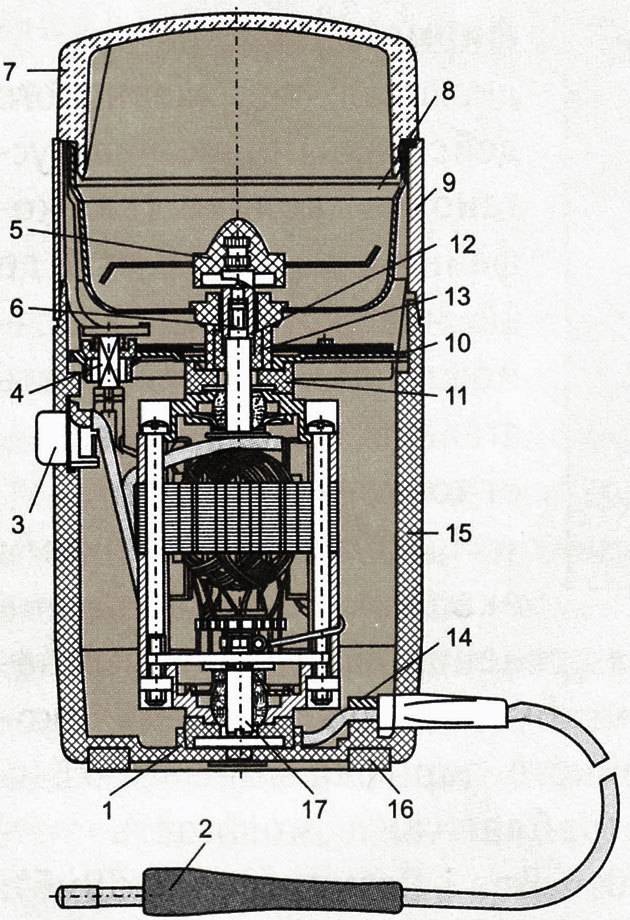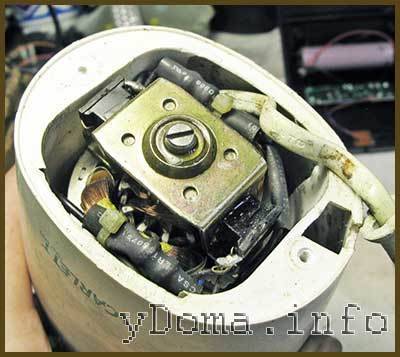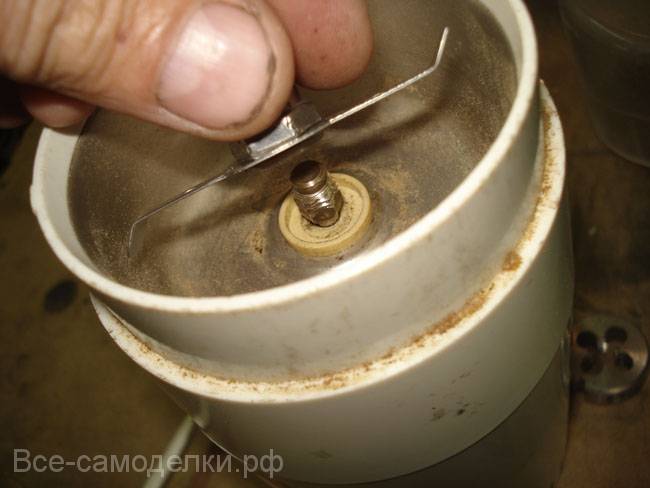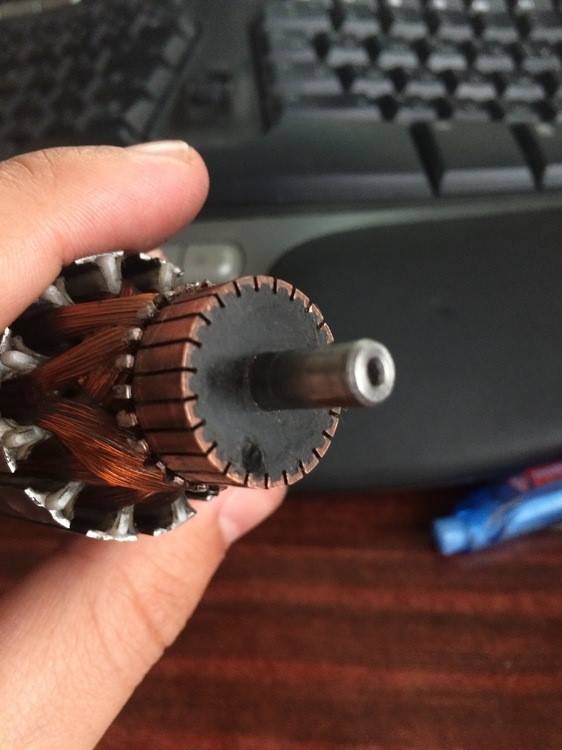How to disassemble
Coffee grinder devices have a simple disassembly scheme that anyone can handle. The main thing is to study the sequence of the algorithm.
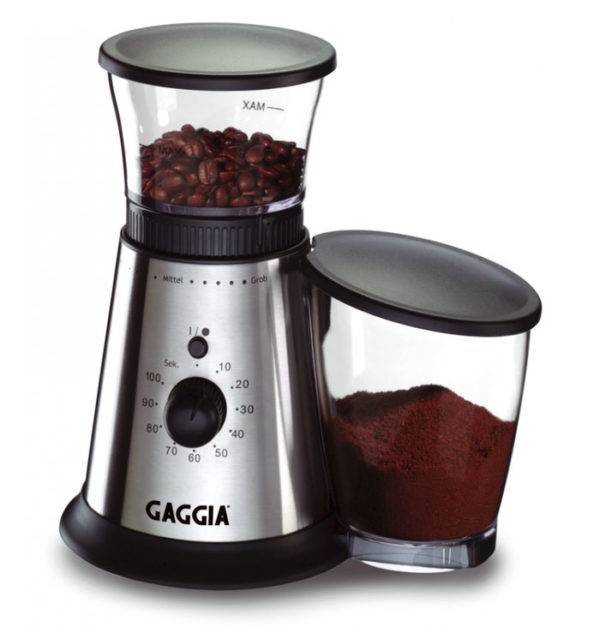
All grinders are of two types:
- with a knife device;
- millstone mills.
Models with a burr device have a separate disassembly mechanism for the grinding mechanism. Moreover, each model can have a different parsing process. But they have common features:
it is worth paying attention to the fact that the devices have conical knives attached to the drive shaft with 3-4 bolts
They can be easily unscrewed with a screwdriver;
when reassembling, it is important to ensure that the bolt heads fit exactly into the seats;
If the bolts are not tightened loosely to the end, then this can lead to the failure of the device in the future.
Also, small metal particles will constantly be found in the grinding, this may be due to the fact that the protruding parts of the fasteners will be in the area of movement of the grinding device;
disassembling the case of coffee grinders is quite simple. To do this, on the lower plane, at the bottom of the device, several self-tapping screws are unscrewed
Access to fasteners can be open or obstructed by the feet of the appliance;
a separate group of coffee grinders may have latches. To do this, it is worth using special probes or screwdrivers, with which you can bend the latches.

Engine
An important part of the device is the engine. In order to dismantle and inspect this element, it is recommended to remove the knives. They can be filmed in several ways:
- when the knife moves clockwise, a left-hand thread is usually applied to the joint surface. To remove, the screwdriver is placed in a special slot and rotated clockwise;
- when the knife moves counterclockwise, the connection has a right-hand thread. Accordingly, the screwdriver probe is also placed in the slot and rotated counterclockwise.

Engine and knife
For a certain time, the fastening part becomes clogged with particles from grinding. It can also be negatively affected by oxides. To remove all this, it is worth using special lubricants, and these tools can also greatly facilitate the process of unscrewing the knife blocks.
If the clamping nut has a tapered thread and is made of bronze metal, then it is worthwhile to slightly warm up the area with the connection. For warming up, you can use a soldering iron.
The subsequent process may depend on the model of the grinder. In any case, the disassembly of the device must be careful, accurate, during it it is imperative to monitor the limiters, all elements must be correctly removed from the grooves.
After the knives are removed, only a few steps are required:
- unscrewing the fixing nut from the plastic base. It secures the grinding bowl;
- when unscrewing the fastener, it is worth watching the gasket from the felt base. It should never be lost;
- then the axle washer is removed, which is made of a metal base;
- then the blocker plate is removed. To do this, it is gently pressed downward and removed from the area with the restrictive grooves.
Usually, for most models of coffee grinders, the parsing process ends with the removal of the dirt-proof washers and the dismantling of the power wire, the switch. Often, in the process of disassembling the device, it can be revealed that the breakdown occurred precisely because of the washer, for example, it burst or completely collapsed.
Repairing a coffee grinder is not difficult, the main thing is to properly disassemble the device.During the parsing, the sequence must be followed, which will also need to be followed in the process of assembling the device back.
If, during parsing, it is revealed that some element has broken or collapsed, then it is better to find out the detailing of the constituent parts for the coffee grinder model, this can be found on the Internet or in the instructions. Then you can go to the store or to the market to purchase a part exactly by number and series.
How to set up the grinding operation
In a manual grinder, the grind size is adjusted using manual adjustment. Typically, the adjusting screw is located where the rotating millstone is attached. By screwing or releasing it, you can achieve such a size of the gap between the millstones, at which the particle size will be optimal. However, you cannot overdo it when reducing the gap. If you set it too small, the metal surfaces will rub against each other, creating small chips that will mix with the coffee and get into the food.
If a rotary coffee grinder with rotating knives is used, the time for complete grinding is determined by visual inspection. To do this, turn off the grinder, open the lid and assess the degree of readiness. If the powder is not fine enough, the procedure is repeated. Many grinders of this type usually have a transparent plastic lid. This allows you to control the grinding process without removing the cover or turning off the engine.
If the coffee grinder works according to the principle of grinding with millstones, then the degree of grinding is regulated using a special adjusting device. This mechanism allows you to increase or decrease the gap between the rotating millstones, and thus change the size of the powder at the exit. In practice, this is expressed in the rotation of the adjusting wheel located on the grinder body. The adjustment algorithm is quite simple. Rotation of the wheel in one direction leads to an increase in the fraction of ground coffee. In the opposite direction - to decrease. In everyday life, everyone can, with a little experimenting, achieve the desired degree of grinding of the grains.
How to Disassemble a Coffee Grinder: Repairing an Electric Coffee Grinder
You will need:
- Work surface preparation
- Screwdriver
- Sharp object
- Technique instruction
- Identifying the problem
#1
The first thing to do is to thoroughly wash the grinder and prepare the work surface. The question of how to disassemble a coffee grinder is not so difficult, especially when it comes to a mechanical model.
Disassembling an electric coffee grinder is a much more time-consuming task, largely due to possible problems with the wire and plug. If we are talking about a complex electrical mechanism with several modes and a power supply, then it is better not to undertake self-repair, because there are many parts in the technique.
Disassemble this technique into parts on a flat and clean surface.
The mechanism of the coffee grinder device itself is extremely simple, but this thing contains a dozen small bolts and nuts, and it is important not to lose any of them. It is worth starting to disassemble the coffee grinder only after its surface is completely dry.
#2
To disassemble this technique, you will need several screwdrivers. The first step is to remove the knife, with which the coffee beans are ground. Usually the nuts holding the knife inside the grinder are located on the bottom of the equipment.
It is worth removing the knife carefully so as not to damage the fastening element.
Usually the blades of such a part are very sharp, and here it is important not to get hurt. Turn the screwdriver counterclockwise
Usually the nut comes off quite easily, and the process itself takes no more than a couple of minutes.
A thin disc is usually located between the surface of the case and this important part, which is essential for the normal operation of the coffee grinder. All three of these details should be immediately put aside, remembering how it was located
#3
For many electric models, the lid is not attached to the base with nuts, but thanks to a special mechanism, and it is not easy to cope with it without the materials at hand.
That is why a person needs to take a thin and sharp object, such as a knife, and try to insert it into the tiny gap between two pieces of equipment. Next, you need to slightly press on the base and turn the knife in one direction and the other.
This is usually enough to free the two parts of the grinder from each other.
By the way, usually electric models are made of plastic, so you need to act very carefully so that the base or cover does not crack.
#4
It is simply impossible to eliminate possible equipment breakdowns without instructions for the coffee grinder. Usually in such a brochure, not only the name of each part is indicated, but also its technical purpose, as well as an approximate appearance. Often the process of assembling equipment is also prescribed there.
After cleaning all the details, a person will be able to determine for what reason his technique has become worse to work. One of the most common problems is the dullness of the knife blades, which grinds the grains. After checking the blades for sharpness, a person can sharpen them or replace the knife with a new one.
If we are talking about an electric coffee grinder, then the problem may be precisely in the cord with which the equipment is connected to the mains. The cord must be disconnected and the safety of each wire must be checked.
#5
At first glance, there is nothing difficult in assembling a coffee grinder, because when disassembling it, a person automatically remembers the sequence of his actions.
Here are just a variety of small screws and nuts, with the help of which the elements of technology are attached, often makes the home craftsman think about his actions. The first thing to do is screw the knife back on.
For this, the same screwdriver will be used, only you need to rotate it clockwise. Next, you should attach a handle to the lid of the coffee grinder, and then start fixing the two parts to the base of the coffee grinder.
Causes of breakdowns and prevention
The simplest and most common cause of any grinder malfunction is clogging. Powder and external debris often fall under the screw and get stuck there, in cheap models - they accumulate inside the case, threatening the motor with overheating.
Sometimes the device refuses to work not because of a breakdown, but because of sensitive sensors. Modern rotary coffee grinders are equipped with fuses that prevent the motor from starting unless the lid is completely closed. If coffee powder gets into the grooves for the thorns, the sensors record insufficient tightness. Such a gap is often not noticeable to the eye.

If the appliance is used for other purposes, such as grinding salt or pepper, there is a high probability that the rotary screw will become stuck. Salt also provokes rust, which is not desirable at all. To rinse the bushing and screw, it is better to use alcohol, which evaporates quickly and does not increase the humidity inside the device.
Burr grinders are more likely than clogged to suffer from electronics abnormalities. In particular, the capacitor fails - it is completely replaced if the house has a soldering iron and solder, it is not difficult to find an analogue in any radio parts store.
An analysis of the electrical malfunction of the Zauber Z-490 coffee grinder is in the video below.
There are also complaints on the forums that the rotary screw cannot be unscrewed. If it clogs up on the axis or gets rusty, it is enough to drip it with alcohol and leave it for a while. If the plastic base, in which the blades are held, is flattened or otherwise deformed, it will either have to be drilled out, or a screw / nail must be fused into it and then removed.
Prophylaxis
To avoid problems, it is enough to follow a few simple rules:
- Store the appliance in a dry place, do not wash, but only sweep or wipe.
- Clean the device from time to time (small - with a brush or a brush, large - with a vacuum cleaner and a brush), this is vital for millstones, semi-professional devices need a general cleaning every 2000 portions.
- Do not exceed the permissible load, this also applies to the volume of the loaded beans and the duration of one grinding session. In the instructions for most rotary coffee grinders, a limit of 2-5 seconds is indicated, after which the appliance needs to "rest" for the same amount of time.
- Use the device only for its intended purpose.

Modern coffee grinders are often more powerful than Soviet ones, but they are inferior to them in terms of durability, especially when it comes to rotary ones. Millstones are designed for more frequent use, but, as practice shows, they are often let down by electronics. Today there are many service centers ready to service the coffee grinder, but if you follow simple rules, the unit will last a long time without repair.
A bit of history
The birth of the electric coffee grinder is marked in history on April 3, 1829. On this day, James Carrington received a patent for his electromechanical invention. Up to this point, coffee was ground manually, using a manual coffee grinder. Its device was a reduced copy of a mill, and coffee beans were ground by grinding them between two millstones. With the use of an electric motor, two designs of coffee grinders appeared. In one, the same traditional millstones are used, and this type is called a millstone. In another, metal knives rotating at high speed took on the role of the grinder and therefore the coffee grinder is called rotary.
The millstone type of a coffee grinder consists of three sections. Whole grains are poured into one. In the second, they are ground and poured into the third section on their own in the form of a ready-to-use powder.
Photo: types of coffee grinders
The rotary coffee grinder has one section, in which the loaded beans are ground by means of a crushing mechanism and poured out manually.
Crushes beans with metal knives Grinds coffee with metal or ceramic burrs Powered by hand
In addition, a modern coffee grinder is equipped with additional systems that make it possible to use the capabilities of the machine more productively.
— Blocking of starting the engine when the cover is open.
Prevents spilling of grains when trying to turn on the motor with an open or loosely closed lid. As a rule, all grinders are equipped with this function. Blocking is especially relevant in rotary devices.
— Motor overheating protection.
Automatic shutdown of the motor in case of excessive heat. This function significantly extends the life of the unit.
— Pulse mode.
A very useful mode when crushing especially hard products. For example, when grinding dried rose hips or hawthorn berries before brewing. It consists in the fact that the operation of the engine alternates with short pauses, during which the speed of rotation of the working shaft decreases.
— Timer.
A timer in rotary coffee grinders regulates the grinding degree. The longer the grinding process takes, the finer the outgoing product becomes.
— Grinding "depth" regulator.
Usually used in grinders with burrs. Adjustment is carried out by decreasing or increasing the gap between the burrs. Numerous recipes for preparing a coffee drink are based precisely on different fractions of ground coffee beans.
So, for example, for cooking (cezve), the finest grinding "into dust" is needed. The espresso is slightly coarser for brewing, and the coarser grind is used for the French press. In total, experts have up to 25 degrees of coffee grinding.
Equipping the coffee grinder with an electric motor greatly facilitated the housewife's work, since grinding coffee beans by hand is a rather tedious task.
Soviet model
The most common model of the past years is 3MM. If it does not break, then you still have to clean it and carry out preventive work. In order not to be mistaken, you should know that the works have the following principle:
- Unscrew the knife. It is held by a slot that is fixed at the bottom. Unscrews counterclockwise.
- There is a nut under the knife. It can be unscrewed with any available tool.
- The plastic cup holder can be removed with the glass.
- The axle remains - it is restrained on the washer, everything is removed.
- The heating plate is fixed with grooves, so light pressure and rotation is made.
- To remove the switch, the spring must be displaced.
- The protective plate will be visible there - it can be easily removed.
- Then the screws are unscrewed, the electrical wire is fixed. After that, the engine is removed.
This is how they begin to repair the coffee grinder with their own hands. As you parse it, it is worth reviewing every detail for integrity. On every household appliance, the knife is securely fixed. If you break the thread during promotion, then you will not be able to disassemble anything further. Therefore, it is worth stocking up on lubricants, splashing on the bolt, holding it for a few minutes and only after that continue to work.
Many devices released in Soviet times are suitable for this parsing system (the millstones for the coffee grinder are also changing). If the instruction is lost over time, then this recommendation is taken as a basis. When you remove the cover, it becomes clear how to proceed further.
Possible causes of failure, their elimination and repair
From time to time, any technique malfunctions. This happens either due to wear of the mechanism, or with the occurrence of a particular emergency situation. The grinder is no exception in this regard. Despite the extreme simplicity of the device, problems occur in its operation. They can be conditionally divided into two categories.
The first includes malfunctions that change the quality of work. This is, first of all, insufficient grinding of the coffee beans. This happens with prolonged use of the device without current routine maintenance. So knives and millstones need to be updated from time to time. If this is not done in a timely manner, the degree of grind will gradually, but inevitably, decrease.
In rotary coffee grinders, the crushing blade must be replaced. Sharpening it at home will not lead to anything good, since there is a high probability of disrupting the balance of the product. An unbalanced knife at high speeds will create vibration and the quality of chopping will not change noticeably. Since the cost of a replacement knife is quite democratic, replacing it will not cause financial stress. The replacement is made by rotating the knife in the same direction in which it works. In order to prevent it from turning with the drive shaft, the engine is jammed with a screwdriver. The old knife is removed, the new one is installed in its place.
The millstones are changed in the millstones. Millstones come in various shapes (plane-parallel and tapered) and are made of different materials (stainless steel or ceramic). In addition, various companies that produce coffee grinders use different types of attachments for millstones. All this complicates the general recommendations for their replacement, but most often this operation is described in detail in the operating manual of the device. Having studied them carefully, everyone can make a replacement on their own at home.
After replacing the millstones, their adjustment to the fineness of grinding becomes relevant.
Types of problems and their elimination
In order for the elimination of the malfunction to be correct, it is required to consider the nuances of the repair. Breakdowns may vary in severity. Some of them can be fixed on your own, while others may require professional help.
In order to repair the engine or to establish its operability, it is necessary to have a multimeter in stock. In addition, you need to have some ability and knowledge to use the device.
At home, you can do the repair of minor breakdowns, which can be eliminated in the absence of skills.
Power cable breakage and blockage failure
Damage to the power cable can be seen visually without special diagnostics. If the bend area is located near the case, then the breakage can be detected quite simply - just move the wire. If the device works, turns on, then it will be necessary to replace the cable.
Locking failure can occur due to clogging of the mechanism. It is located in the area of the lid groove line. Also, this breakdown may occur due to the lack of pressure on the inner plate. Checking the blocking can be done easily:
- for repairs, you will need a thin screwdriver, with which you press on the protruding element;
- if when pressed, the coffee grinder is triggered, then you need to disassemble it;
- then you need to fix all the problems.
Device does not start
A household coffee grinder may not start for several reasons:
- broken cable inside the device. To fix it, you will need to have skills in working with a soldering iron;
- perhaps a contact has come off inside, which can be soldered in place with a soldering iron;
- if the device does not pray, then this can happen due to the complete failure of the engine.

Internal cables and contacts
If an engine breakdown occurs, then the repair will require knowledge and experience. In this case, fixing it will be ineffective, it can cost a good amount. This will require rewinding or purchasing a new engine. In these situations, it is best to buy a new grinder.
Uneven movement of the knife, there is a sharp decrease in revolutions with increasing grinding
The main reason for the appearance of this breakdown is the partial upsetting of the motor or the burnout of one of the windings. It also negatively affects the power of the device.
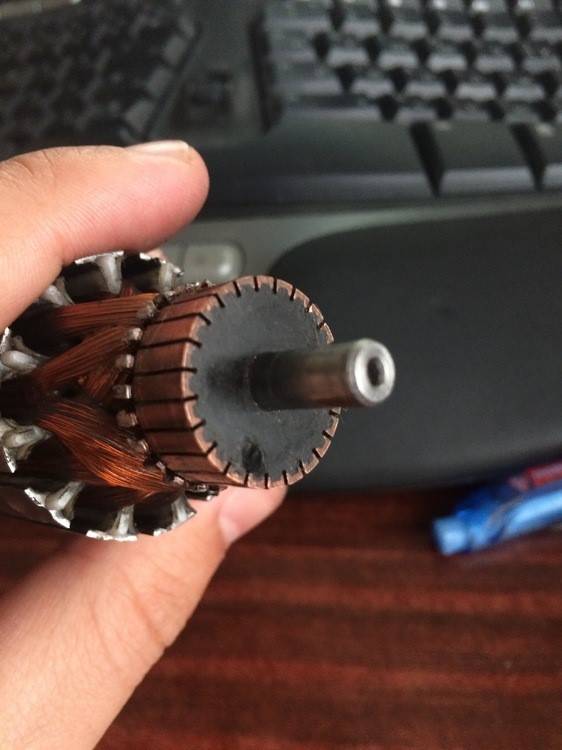
Anchor or engine
Fixing can be difficult. It is advisable to take the device to a workshop for professional diagnostics. After it, the specialist determines the method of repair - rewinding or complete replacement.
A burning smell appears during operation
The main cause of this malfunction is contamination or oxidation of bearings and sleeve bushings. Additionally, the speed of the device is reduced. This problem is often seen with the Bosch 6000 series coffee grinders.

Cleaning the appliance
To fix the problem, you need to do the following:
- the device must be analyzed;
- the ease of sliding is checked for all blocks;
- bearings are lubricated if necessary.
If this problem occurs with a Bosch 6000 series coffee grinder, then the repair is done as follows:
- it is necessary to remove the sliding sleeve from the upper part of the shaft;
- then the shaft is processed with an alcohol solution;
- in the presence of corrosive damage, it will need to be removed with special means.

Everything is done with the help of tools at hand
Corrosion can be removed with a zero emery cloth
When cleaning, be careful not to damage important parts.
How to grind coffee and use the machine correctly
True gourmets of the drink claim that when preparing coffee, the most important thing is its correct grinding. There is a whole science that describes all the nuances of this seemingly simple operation. Due to the fact that the popularity of coffee consumption has recently become huge, there are narrow professionals in this area of cooking. Sometimes their opinions differ.However, in matters of grinding coffee beans, experts tend to believe that the correct grinding takes place either in a manual coffee grinder or in an electric coffee grinder equipped with a millstone. The rotary grinder grinds less evenly, and the final product contains particles of different sizes. In addition, at high knife speeds, the coffee burns, which leads to a change in its taste.
The grinding time should not be long. As well as the time from grinding to brewing the drink. The longer the coffee is ground, the more essential oils evaporate. Therefore, the optimal grinding time is considered to be no more than 20 seconds.
Over time, the grinder began to be used not only for coffee. It can crush nuts, eggshells, cereals, salt, sugar and other bulk food products. For example, at home, using a coffee grinder, you can make powdered sugar from ordinary loose sugar.
In culinary practice, powder with an admixture of fragrant nutmeg is also used. To do this, first grind a well-dried nut, and then add sugar to it and grind everything together.
It is not recommended to grind foods with a persistent smell in the same grinder. So, for example, you should not crush pepper in it, the persistent smell of which can then be transferred to the coffee drink.
The device is frozen, does not respond
Modern electric coffee grinders are much more convenient than older models, in which the grinding of beans had to be done manually - now the technology will do everything for you, and the task will take only a few seconds to complete. However, this progress also has a downside. So, in some cases, after switching on, the equipment may simply freeze, not responding to any user actions. In certain situations, the device may also freeze during the execution of any programs, and the device often does not even respond to the shutdown button.
Often there are only two reasons for such a malfunction. The first is to use the grinder for other purposes: the device may freeze due to attempts to grind other products in it, such as nuts or sugar. Another common cause of a malfunction is the failure of electronics - this can occur both due to natural wear of parts, and due to the burnout of some elements as a result of a voltage drop. Repairing a coffee maker in this case is a technically complex process, which only a qualified specialist can handle. Therefore, at the first sign of a malfunction, it is worth contacting professionals.
Is there a broken part or the lid of the grinder? It is quite simple to fix it with your own hands, although many think quite the opposite. True connoisseurs of coffee prefer to drink it from freshly ground coffee beans, and neglect the instant drink. Such coffee retains its aroma and unique taste longer. More recently, coffee beans were ground using manual coffee mills, and only after the advent of various household electrical appliances, the process became much easier. But very often from non-observance of the rules for using the equipment or from their ignorance, electric coffee grinders fail. In our article we will tell you how to identify the cause of a malfunction, how to repair a coffee grinder with your own hands.
How to disassemble the device
The most popular model is the Bosch Rotary Coffee Grinder. You can put about 75 g of grains into it at a time, and stainless steel knives are able to grind them into the finest dust.
If the Bosch mkm 6000 coffee grinder does not turn on, you first need to disassemble it and get to the insides hidden in the plastic case
The Bosch coffee grinder must be disassembled carefully: turn it upside down, squeeze the case, turn the bottom and then the latches will open. How to fix a Bosch coffee grinder depending on the breakdown:
check the circuit with a tester;
clean the details;
lubricate the moving mechanism.
If the engine burns out, take it to the service or buy a new one.
How to disassemble
Coffee grinder devices have a simple disassembly scheme that anyone can handle. The main thing is to study the sequence of the algorithm.
Coffee grinder model
All grinders come in two flavors:
- with a knife device;
- millstone mills.
Models with a burr device have a separate disassembly mechanism for the grinding mechanism. Moreover, each model can have a different parsing process. But they have common features:
it is worth paying attention to the fact that the devices have conical knives attached to the drive shaft with 3-4 bolts
They can be easily unscrewed with a screwdriver;
when reassembling, it is important to ensure that the bolt heads fit exactly into the seats;
If the bolts are not tightened loosely to the end, then this may further lead to the failure of the device.
Also, small metal particles will constantly be found in the grinding, this may be due to the fact that the protruding parts of the fasteners will be in the area of movement of the grinding device;
disassembling the case of coffee grinders is quite simple. To do this, on the lower plane, at the bottom of the device, several self-tapping screws are unscrewed
Access to fasteners can be open or obstructed by the feet of the appliance;
a separate group of grinders may have latches. To do this, it is worth using special probes or screwdrivers, with which you can bend the latches.
Disassembled coffee grinder
An important part of the device is the engine. In order to dismantle and inspect this element, it is recommended to remove the knives. They can be filmed in several ways:
- when the knife moves clockwise, a left-hand thread is usually applied to the joint surface. To remove, the screwdriver is placed in a special slot and rotated clockwise;
- when the knife moves counterclockwise, the connection has a right-hand thread. Accordingly, the screwdriver probe is also placed in the slot and rotated counterclockwise.
Engine and knife
For a certain time, the fastening part becomes clogged with particles from grinding. Oxides can also have a negative effect on it. To remove all this, it is worth using special lubricants, and these tools can also greatly facilitate the process of unscrewing the knife blocks.
If the clamping nut has a tapered thread and is made of bronze metal, then it is worthwhile to slightly warm up the area with the connection. For warming up, you can use a soldering iron.
The subsequent process may depend on the model of the grinder. In any case, the disassembly of the device must be careful, accurate, during it it is imperative to monitor the limiters, all elements must be correctly removed from the grooves.
After the knives are removed, only a few steps are required:
- the fixing nut from the plastic base is unscrewed. It secures the grinding bowl;
- when unscrewing the fastener, it is worth watching the gasket from the felt base. It should never be lost;
- then the axle washer is removed, which is made of a metal base;
- then the blocker plate is removed. To do this, it is gently pressed downward and removed from the area with restrictive grooves.
Usually, for most models of coffee grinders, the parsing process ends with the removal of the dirt-proof washers and the dismantling of the power wire, the switch. Often, in the process of disassembling the device, it can be revealed that the breakdown occurred precisely because of the washer, for example, it burst or completely collapsed.
Repairing a coffee grinder is not difficult, the main thing is to properly disassemble the device.During the parsing, the sequence must be followed, which will also need to be followed in the process of assembling the device back.
If, during parsing, it is revealed that some element has broken or collapsed, then it is better to find out the detailing of the constituent parts for the coffee grinder model, this can be found on the Internet or in the instructions. Then you can go to the store or to the market to purchase a part exactly by number and series.




































